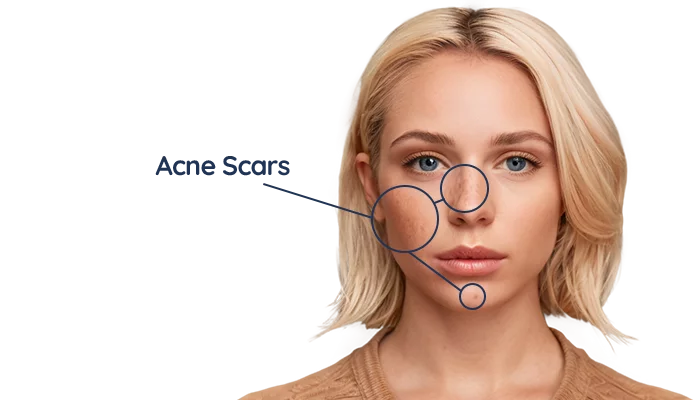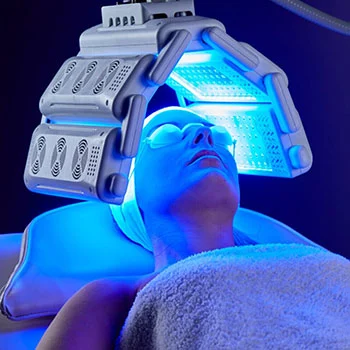What is laser skin resurfacing?
The skin is the largest organ of our body that plays a critical role in our health and beauty. Since the skin is the first line of our body’s defense against intrusions and infections, environmental factors and pollutants such as sun rays, air particulates, gravity, and germs, sometimes negatively affect its appearance, resulting in skin conditions such as wrinkles, dark patches, etc. Laser skin resurfacing is here to help you get rid of these issues and make your skin glowing with youthfulness.
Laser skin resurfacing, also sometimes called laserbrasion, laser peel, or laser vaporization, uses a laser beam to vaporize skin layers at different levels to give way to the growth of new skin with more elasticity, clarity, and youthfulness.
Laserbrasion is effective in treating acne scars, blotches, signs of aging such as fine lines, and wrinkles around the eyes (crow’s feet), mouth wrinkles (smoker’s lines), and forehead lines (frown lines). Chickenpox scars, sun spots, liver spots, dull complexion, enlarged pores, warts, linear epidermal nevi, varicose veins (spider veins), vascular lesions, and post-facelift unresponsiveness can also be addressed with laser skin resurfacing. It may also be used to remove birthmarks such as port-wine stains and tattoos.
Following the procedure, the skin will be:
- Even in tone and texture
- Youthful looking
- Smooth and soft
- Plump and firm
- Vibrant and healthy
- Wrinkle-free
- Clear (from spots, scars, birthmarks, spider veins, etc.)
Laser skin resurfacing is a proven method to rejuvenate the skin, which has the following benefits:
- Safe and effective
- Minimal discomfort
- Minimal side effects
- Short downtime
The precision of laser skin resurfacing is higher than other procedures thanks to rapid development in new laser technologies, which is most helpful in delicate areas such as around the eyes. Although facial laser is more effective and common, it is also applicable to the neck, chest, hands, arms, and legs. Laser skin resurfacing can be done on its own or in combination with other treatments.
Laser skin resurfacing is performed by a board-certified dermatologist or plastic surgeon in an outpatient facility. The experience and qualification of the doctor make a big difference in the outcome.
Who are good candidates for laser skin resurfacing?
Anyone with good overall health can undergo laser skin rejuvenation treatment. However, people who are prone to cold sores, fever blisters, and active acne are advised to avoid this therapy because a breakout might occur.
Those who have taken isotretinoin acne medication (Accutane, Myorisan, Claravis, Zenatane) in the past year should delay this procedure since the chance of scarring is high.
Excessively sagging skin will not respond well to this treatment.
Patients with a compromised immune system or those who had radiation therapy are advised to avoid this procedure.
Pregnancy and breastfeeding are also contradictory to this treatment due to hormonal changes that impact the results.
What are the different types of laser skin resurfacing?
Laser skin resurfacing utilizes laser beams which are just concentrated pulsating short waves of lights that are targeted at skin layers to encourage collagen production. The beams can also be broken as in fractional lasers to create many fine beams to target only a fraction of the skin and leave behind microscopic strips of untreated areas.
There are 2 types of lasers based on the level of skin removal, each of which has several techniques and devices:
1. Ablative lasers
This is the type of laser that vaporizes the epidermis (top layer of the skin) and heats the dermis (middle layer of the skin) so collagen and elastin production is stimulated and deep skin issues such as warts, enlarged pores on the nose, deep scars and wrinkles can be addressed. An ablative laser resurfacing is an invasive procedure that might require local anesthesia or intravenous sedation. That is why the downtime period is longer, at least 2-3 weeks, to allow the new skin to form and heal completely. The possible side effects are also more noticeable. Ablative lasers include carbon dioxide (CO2) lasers and Erbium.
The CO2 lasers are not suitable for dark skin tones due to the risk of changes in pigmentation.
2. Nonablative lasers
This is the type of laser that does not cause wounds in the skin but rather improves tone and texture by targeting superficial layers to treat fine lines, sun spots, and lax skin. This makes it an ideal choice for collagen remodeling even in the hands, neck, and chest. Darker skin tones can also benefit from this type of laser therapy. There is not much pain associated with the treatment and only a topical numbing agent is applied before the procedure. The downtime is also shorter. However, multiple sessions are required to achieve a substantial result.
Erbium lasers, IPL (intense pulsed light) photorejuvenation, pulsed-dye lasers (vascular), and alexandrite lasers are non-ablative.
What to expect from the laser skin resurfacing procedure? Preparation
You will have a consultation session with a dermatologist or plastic surgeon to find out if you are an ideal candidate for laser skin resurfacing. Your doctor will examine your skin and give you an analysis of what can be achieved. They will ask you about your current health issues and the medications you are taking to evaluate possible interactions. Conditions such as cold sores and fever blisters might respond aggressively by triggering a breakout. Feel free to ask your questions and discuss your concerns. Express your true desires and have realistic expectations.
Then a customized 4-to-6-week preparation period starts according to your individual needs to prevent complications and maximize results. Unprotected sun exposure should be avoided in this period since it can cause irregular pigmentation. Other skin treatments such as chemical peels and dermabrasion should be avoided too.
Smoking is off limits 2 weeks before and after the procedure since it can hinder the healing process. You might be ordered to stop taking some medications such as ibuprofen and aspirin or supplements such as vitamin E at least 10 days before the treatment to prevent excessive bleeding. Medications that increase photosensitivity such as doxycycline or minocycline should be stopped 72 hours before the procedure.
Antibiotic and antiviral medications might be prescribed to prevent infection while your skin is exposed during laser therapy and the healing period. Topical retinoid might also be given 4 weeks in advance to prepare the skin. Some pictures may be taken for the purpose of before and after comparison.
It is highly recommended to have laser skin resurfacing in the fall or winter season since your skin will be sensitive and sun exposure is the lowest in cold seasons.
How it’s done
Laser skin resurfacing is performed on an outpatient basis in a clinic or doctor’s office. For facial skin resurfacing, your eyes will be covered by protective Goggles. Your skin will be numbed to prevent possible sensations of pain and you may even be sedated if the procedure is extensive, normally in ablative laser therapies.
During the procedure, the dermatologist applies a beam of light to the skin, which removes the outer layer of the skin (in ablative lasers) and heats the middle layer (dermis) to produce more collagen.
A laser treatment usually takes from 15 minutes to 2 hours depending on the treatment area. However, if the more extensive procedures; a full-face laser skin resurfacing can take up to 2 hours but individual areas such as around the eyes or mouth might take 30 to 45 minutes.
After the procedure (recovery)
The treated area will have an airtight bandage for 24 hours and you will be instructed to clean the area with prescribed cleansers 4-5 times a day. Your doctor may also prescribe an ointment such as petroleum jelly to prevent scab forming. Follow-up visits will be in order to evaluate the healing speed and quality.
You will experience swelling following the procedure, which is a normal response of the body to any damage. In severe cases, steroids are prescribed to reduce swelling around your eyes. Cool compressors in the first 48 hours can also help as is sleeping with the head elevated on an extra pillow for the first week. Pain relievers might be prescribed to manage possible pain.
Depending on the depth of treatment, you might experience 2-3 weeks of downtime until your new skin is completely formed and heals. During this period, you should avoid any situation that has high levels of infection risk such as the gym, swimming pool, and sauna. Exercises that cause flushing are also not a good idea.
Rubbing and scratching will irritate the skin and increase the chance of infection. Harsh sunscreen and cosmetic products are banned during the healing process in the initial month. Your skin will be super sensitive to environmental exposures such as the sun so you will need to avoid direct sun exposure for a year after treatment. It is best to avoid smoking during the healing period.
To cover the pink or red tone of your skin, you can use green-based camouflages, but only if your doctor allows it. It is critically important you follow your doctor's guidelines for a full recovery and desired outcome.
Laser skin resurfacing results will be evident after a month. The full results, however, will be achieved after 3 to 6 months. Daily moisturizers and sunscreen are essential during this time.
What are the risks of laser skin resurfacing?
Swelling, redness, itching, and peeling are common side effects due to the healing process. However, they are more intense in ablative than in non-ablative laser therapy.
White bumps (milia) might develop on the treated area, which are due to the application of creams and bandages and will dissolve on their own.
Infection, although rare, might develop due to the vulnerability of the skin.
There is some risk of discoloration for dark skin tones such as dark brown and black.
If any unusual symptoms occurred, contact your doctor immediately.
How much does laser skin resurfacing cost?
According to the American Society of Plastic Surgeons, the average cost of ablative laser skin resurfacing in 2020 was $2,509 but for non-ablative lasers, the cost was $1,445.
The price changes according to the experience and qualification of the doctor as well as the location throughout the world.
Laser skin resurfacing is a cosmetic procedure, therefore insurance does not cover the cost. The only exception might be removing the precancerous growth on your skin in which case you should ask before making appointments.
Conclusion
Laser skin resurfacing is a modern skin procedure that can achieve consistent results with minimal discomfort or side effects. The controlled injury caused by laser beams encourages your skin to produce more collagen and elastin, leading to clearer, firmer, and healthier skin. Laser skin resurfacing is a miracle in the world of cosmetic treatments that takes years off your face.


